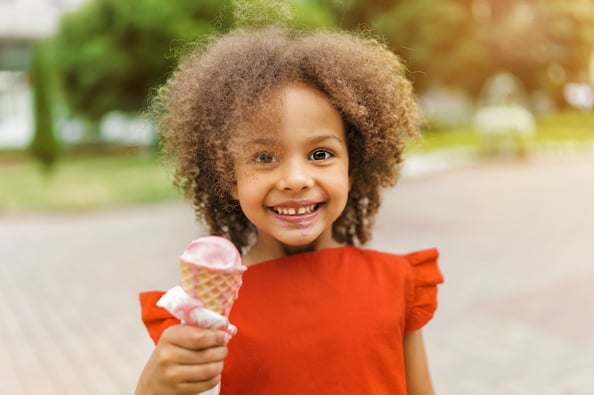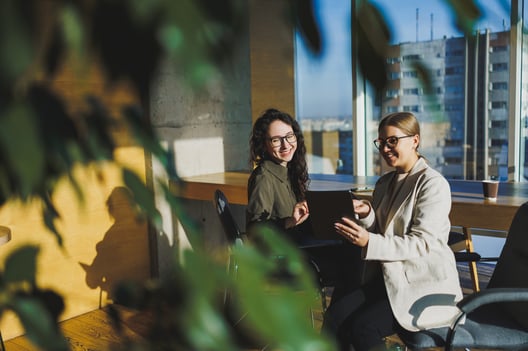Context, Cultural Understanding and Creativity: AI’s Copy Limitations
With seemingly hundreds of AI tools popping up every day, it’s clear that more and more people are interested in ways they can use AI to their advantage. We wanted to explore the marketing potential of these tools. So we decided to put AI to a copywriting test and generate alt text for a variety of images.
Awareness campaigns vs Sales campaigns
A big part of digital accessibility is alt text. Alt text describes the appearance and function of a digital image to be read aloud by screen readers for visually impaired people. Here at Madison Design, we create alt text for websites, PDFs, digital reports and more every day.
What makes good alt text?
Good alt text is accurate and just the right amount of descriptive, capturing the image’s relevance to the topic, which could include what the person is doing or wearing, or their environment. It paints a picture of what’s happening in a clear and concise way. For example, here’s alt text for a stock image of a girl eating ice cream (written by yours truly).

Young girl wearing an orange dress smiles with an ice cream cone in a park.
Could writing alt text be as easy as uploading images and instantly getting AI-generated copy? We quickly discovered that this simple question comes with a complex answer...
The tool
For our AI writing test, we used a tool called alttext.ai. This tool can generate alt text in 130 languages and plugs in seamlessly to Wordpress, Shopify and other platforms businesses already use.
The test
We uploaded 3 different images into alttext.ai to see if it can generate accurate and concise image descriptions the same way Madison can.
IMAGE 1
AI-GENERATED TEXT: a black and white dog wearing a purple shirt.
MADISON-GENERATED TEXT: a black dog with white fur on its nose and chest sits outside, wearing a blue bandana and purple leash. A parked car and several houses are in the background.
ISSUES: Uh-oh! Not quite right. The AI tool must’ve gotten confused by the bandana and the purple leash.
FINAL VERDICT: Human-generated text wins.
Let’s move on to image 2, a stock image of people in an office setting.
IMAGE 2
AI-GENERATED TEXT: a couple of women sitting at a table with a laptop.
MADISON-GENERATED TEXT: A woman wearing glasses and business attire sits at a table and shows a tablet to another woman wearing glasses and business attire. Green leaves from an office plant are in the foreground, and a large office building is in the window in the background.
ISSUES: Much better than our first test on image 1, but still missing a few details, like how the women are in an office setting, or that they are both wearing glasses. Also, the device the woman on the right is holding appears to be a tablet and not a laptop. There’s no mention of the leaves in the foreground, or the fact that the woman on the right appears to be presenting information to the woman on the left.
FINAL VERDICT: Human-generated text wins.
On to image 3, a visually dense image from a recent website we finished for Sleepy Bee.
IMAGE 3
AI-GENERATED TEXT: a woman standing in front of a laptop computer.
MADISON-GENERATED TEXT: A smiling woman wearing a yellow t-shirt with a cartoon bee on it uses a tablet in front of a point-of- sale system. A couple of her coworkers are standing in the background by a coffee bar and plants.
ISSUES: Not only is she not standing in front of a laptop, but several tablets and point-of-sale devices, but the AI completely missed any details about the shirt, the background, and the setting.
FINAL VERDICT: Human-generated text wins.
The results
It was impressive that alttext.ai was able to generate these image descriptions so quickly and with relative accuracy. However, with some of the mistakes and less-specific descriptions, it’s clear that this tool isn’t entirely hands-off. So why are these descriptions a bit off the mark? I went straight to the source and asked ChatGPT about some of the challenges AI faces when generating alt text.
Couldn’t have said it better myself. That extra context of the project, cultural understanding and creativity are the big three difference-makers when it comes to generating alt text the old- fashioned way. As humans, we understand the visual cues that tell you an office is an office, that a person looks frustrated, or that a group of people aren’t just at a generic parade, but an LGBTQ+ pride event.
The future
Now it’s time for the disclaimer. As with any new technology, AI will continue to progress and improve, especially considering Chat GPT’s awareness and assessment of AI’s current limitations. The results of this test could change in just a few months.
But regardless of AI’s strength and weaknesses, collaboration will be the key to maximizing its copy potential. As AI evolves, finding creative and strategic ways to use these tools will be the best way forward. Currently, there are advantages to using an AI tool to generate alt text, especially facing a large batch of images. But we’d recommend building in plenty of time to double-check and revise descriptions as needed.
Ready to talk about alt text, accessibility considerations or marketing goals? Reach out to learn about our collaborative approach.
